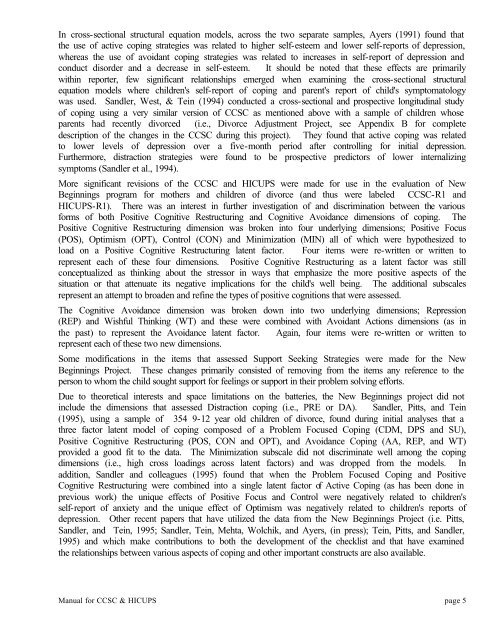Manual for the Children's Coping Strategies Checklist
Manual for the Children's Coping Strategies Checklist
Manual for the Children's Coping Strategies Checklist
You also want an ePaper? Increase the reach of your titles
YUMPU automatically turns print PDFs into web optimized ePapers that Google loves.
In cross-sectional structural equation models, across <strong>the</strong> two separate samples, Ayers (1991) found that<br />
<strong>the</strong> use of active coping strategies was related to higher self-esteem and lower self-reports of depression,<br />
whereas <strong>the</strong> use of avoidant coping strategies was related to increases in self-report of depression and<br />
conduct disorder and a decrease in self-esteem. It should be noted that <strong>the</strong>se effects are primarily<br />
within reporter, few significant relationships emerged when examining <strong>the</strong> cross-sectional structural<br />
equation models where children's self-report of coping and parent's report of child's symptomatology<br />
was used. Sandler, West, & Tein (1994) conducted a cross-sectional and prospective longitudinal study<br />
of coping using a very similar version of CCSC as mentioned above with a sample of children whose<br />
parents had recently divorced (i.e., Divorce Adjustment Project, see Appendix B <strong>for</strong> complete<br />
description of <strong>the</strong> changes in <strong>the</strong> CCSC during this project). They found that active coping was related<br />
to lower levels of depression over a five-month period after controlling <strong>for</strong> initial depression.<br />
Fur<strong>the</strong>rmore, distraction strategies were found to be prospective predictors of lower internalizing<br />
symptoms (Sandler et al., 1994).<br />
More significant revisions of <strong>the</strong> CCSC and HICUPS were made <strong>for</strong> use in <strong>the</strong> evaluation of New<br />
Beginnings program <strong>for</strong> mo<strong>the</strong>rs and children of divorce (and thus were labeled CCSC-R1 and<br />
HICUPS-R1). There was an interest in fur<strong>the</strong>r investigation of and discrimination between <strong>the</strong> various<br />
<strong>for</strong>ms of both Positive Cognitive Restructuring and Cognitive Avoidance dimensions of coping. The<br />
Positive Cognitive Restructuring dimension was broken into four underlying dimensions; Positive Focus<br />
(POS), Optimism (OPT), Control (CON) and Minimization (MIN) all of which were hypo<strong>the</strong>sized to<br />
load on a Positive Cognitive Restructuring latent factor. Four items were re-written or written to<br />
represent each of <strong>the</strong>se four dimensions. Positive Cognitive Restructuring as a latent factor was still<br />
conceptualized as thinking about <strong>the</strong> stressor in ways that emphasize <strong>the</strong> more positive aspects of <strong>the</strong><br />
situation or that attenuate its negative implications <strong>for</strong> <strong>the</strong> child's well being. The additional subscales<br />
represent an attempt to broaden and refine <strong>the</strong> types of positive cognitions that were assessed.<br />
The Cognitive Avoidance dimension was broken down into two underlying dimensions; Repression<br />
(REP) and Wishful Thinking (WT) and <strong>the</strong>se were combined with Avoidant Actions dimensions (as in<br />
<strong>the</strong> past) to represent <strong>the</strong> Avoidance latent factor. Again, four items were re-written or written to<br />
represent each of <strong>the</strong>se two new dimensions.<br />
Some modifications in <strong>the</strong> items that assessed Support Seeking <strong>Strategies</strong> were made <strong>for</strong> <strong>the</strong> New<br />
Beginnings Project. These changes primarily consisted of removing from <strong>the</strong> items any reference to <strong>the</strong><br />
person to whom <strong>the</strong> child sought support <strong>for</strong> feelings or support in <strong>the</strong>ir problem solving ef<strong>for</strong>ts.<br />
Due to <strong>the</strong>oretical interests and space limitations on <strong>the</strong> batteries, <strong>the</strong> New Beginnings project did not<br />
include <strong>the</strong> dimensions that assessed Distraction coping (i.e., PRE or DA). Sandler, Pitts, and Tein<br />
(1995), using a sample of 354 9-12 year old children of divorce, found during initial analyses that a<br />
three factor latent model of coping composed of a Problem Focused <strong>Coping</strong> (CDM, DPS and SU),<br />
Positive Cognitive Restructuring (POS, CON and OPT), and Avoidance <strong>Coping</strong> (AA, REP, and WT)<br />
provided a good fit to <strong>the</strong> data. The Minimization subscale did not discriminate well among <strong>the</strong> coping<br />
dimensions (i.e., high cross loadings across latent factors) and was dropped from <strong>the</strong> models. In<br />
addition, Sandler and colleagues (1995) found that when <strong>the</strong> Problem Focused <strong>Coping</strong> and Positive<br />
Cognitive Restructuring were combined into a single latent factor of Active <strong>Coping</strong> (as has been done in<br />
previous work) <strong>the</strong> unique effects of Positive Focus and Control were negatively related to children's<br />
self-report of anxiety and <strong>the</strong> unique effect of Optimism was negatively related to children's reports of<br />
depression. O<strong>the</strong>r recent papers that have utilized <strong>the</strong> data from <strong>the</strong> New Beginnings Project (i.e. Pitts,<br />
Sandler, and Tein, 1995; Sandler, Tein, Mehta, Wolchik, and Ayers, (in press); Tein, Pitts, and Sandler,<br />
1995) and which make contributions to both <strong>the</strong> development of <strong>the</strong> checklist and that have examined<br />
<strong>the</strong> relationships between various aspects of coping and o<strong>the</strong>r important constructs are also available.<br />
<strong>Manual</strong> <strong>for</strong> CCSC & HICUPS page 5


